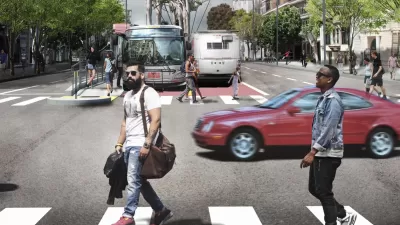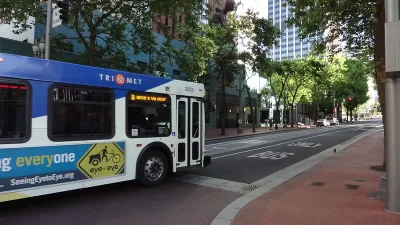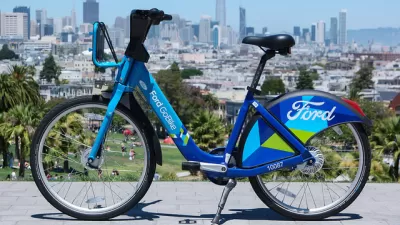Bus lanes along a primary transit corridor have sped up travel times and point to the potential for major citywide improvements.

Alon Levy takes a closer look at the outcomes of a San Francisco project that includes dedicated bus lanes on Mission Street, an arterial with one of the highest transit ridership levels in the city and lots of congestion.
Buses running along the 2.5-mile section are moving two minutes faster, and Muni expects this to increase to five minutes when the project upgrades are complete. "The two minutes of saved travel time represent about 10% of current trip time, and the projected five-minute saving is a quarter of the total travel time," says Levy.
He notes that the program also includes left turn restrictions and forced right turns, which have resulted in decreased traffic on Mission Street. Bus stops along the route were also consolidated to help with travel times.
Levy says that the program so far looks like a complete success and should be replicated in other parts of the city:
City residents who travel to areas not served by BART or by the Muni Metro tunnel would be able to count on buses being there; people who can afford Uber or Lyft might choose to stay on the cheaper bus nonetheless, and people who cannot might still choose to make more trips by bus, creating a virtuous cycle of more ridership and more service.
He argues that in the long run these improvements would help transit riders but could also substantially transform San Francisco’s larger transportation network.
FULL STORY: Mission Bus Lanes Work Wonders For Riders - Pedestrian Observations

Planetizen Federal Action Tracker
A weekly monitor of how Trump’s orders and actions are impacting planners and planning in America.

Chicago’s Ghost Rails
Just beneath the surface of the modern city lie the remnants of its expansive early 20th-century streetcar system.

San Antonio and Austin are Fusing Into one Massive Megaregion
The region spanning the two central Texas cities is growing fast, posing challenges for local infrastructure and water supplies.

Since Zion's Shuttles Went Electric “The Smog is Gone”
Visitors to Zion National Park can enjoy the canyon via the nation’s first fully electric park shuttle system.

Trump Distributing DOT Safety Funds at 1/10 Rate of Biden
Funds for Safe Streets and other transportation safety and equity programs are being held up by administrative reviews and conflicts with the Trump administration’s priorities.

German Cities Subsidize Taxis for Women Amid Wave of Violence
Free or low-cost taxi rides can help women navigate cities more safely, but critics say the programs don't address the root causes of violence against women.
Urban Design for Planners 1: Software Tools
This six-course series explores essential urban design concepts using open source software and equips planners with the tools they need to participate fully in the urban design process.
Planning for Universal Design
Learn the tools for implementing Universal Design in planning regulations.
planning NEXT
Appalachian Highlands Housing Partners
Mpact (founded as Rail~Volution)
City of Camden Redevelopment Agency
City of Astoria
City of Portland
City of Laramie





























